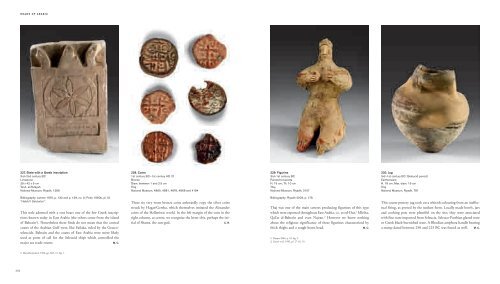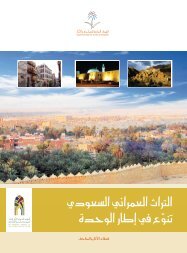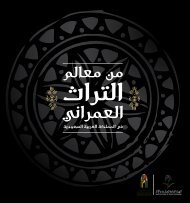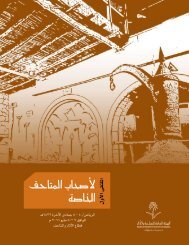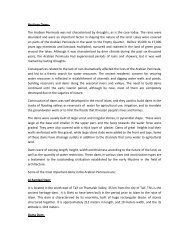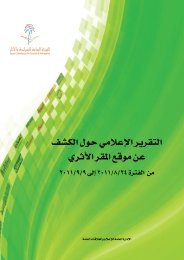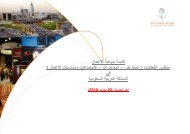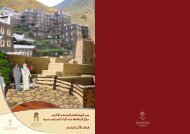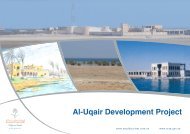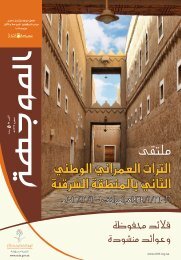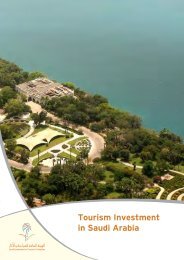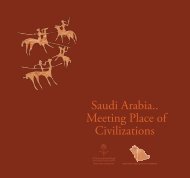Roads of Arabia
Roads of Arabia
Roads of Arabia
You also want an ePaper? Increase the reach of your titles
YUMPU automatically turns print PDFs into web optimized ePapers that Google loves.
20 Arabie US_p372-385_BAT.qxd 23/06/10 22:02 Page 384<br />
ROADS OF ARABIA<br />
227. Stele with a Greek inscription<br />
3rd–2nd century BC<br />
Limestone<br />
29 x 42 x 9 cm<br />
Tarut, al-Rufayah<br />
National Museum, Riyadh, 1289<br />
228. Coins<br />
1st century BC–1st century AD (?)<br />
Bronze<br />
Diam. between 1 and 2.5 cm<br />
Thaj<br />
National Museum, 4880, 4881, 4876, 4868 and 4184<br />
229. Figurine<br />
3rd–1st century BC<br />
Painted terracotta<br />
H. 15 cm; Th. 10 cm<br />
Thaj<br />
National Museum, Riyadh, 3107<br />
230. Jug<br />
3rd–1st century BC (Seleucid period)<br />
Earthenware<br />
H. 18 cm; Max. diam. 19 cm<br />
Thaj<br />
National Museum, Riyadh, 781<br />
Bibliography: Jamme 1970, p. 132 and p. 139, no. 6; Potts 1990b, pl. III;<br />
“Habib’il Salutation”.<br />
This stele adorned with a rose bears one <strong>of</strong> the few Greek inscriptions<br />
known today in East <strong>Arabia</strong> (the others come from the island<br />
<strong>of</strong> Bahrain 1 ). Nonetheless these finds do not mean that the central<br />
coasts <strong>of</strong> the <strong>Arabia</strong>n Gulf were, like Failaka, ruled by the Graecoseleucids.<br />
Bahrain and the coasts <strong>of</strong> East <strong>Arabia</strong> were more likely<br />
used as ports <strong>of</strong> call for the Seleucid ships which controlled the<br />
major sea trade routes. M. C.<br />
These six very worn bronze coins awkwardly copy the silver coins<br />
struck by Hagar/Gerrha, which themselves imitated the Alexander<br />
coins <strong>of</strong> the Hellenistic world. In the left margin <strong>of</strong> the coin in the<br />
right column, at centre, we recognize the letter shin, perhaps the initial<br />
<strong>of</strong> Shams, the sun-god. C. R.<br />
Bibliography: Riyadh 2009, p. 179.<br />
Thaj was one <strong>of</strong> the main centres producing figurines <strong>of</strong> this type<br />
which were exported throughout East <strong>Arabia</strong>, i.e. to ed-Dur, 1 Mleiha,<br />
Qal’at al-Bahreïn and even Najran. 2 However we know nothing<br />
about the religious significance <strong>of</strong> these figurines characterized by<br />
thick thighs and a rough-hewn head. M. C.<br />
1. Daems 2004, p. 94, fig. 2.<br />
2. Zarins et al. 1983, pl. 27-18, 19.<br />
This coarse pottery jug took on a whitish colouring from an ineffectual<br />
firing, as proved by the sunken form. Locally made bowls, jars<br />
and cooking pots were plentiful on the site; they were associated<br />
with fine ware imported from Seleucia, Seleuco-Parthian glazed ware<br />
or Greek black-burnished ware. A Rhodian amphora handle bearing<br />
a stamp dated between 250 and 225 BC was found as well. M. C.<br />
1. Marcillet Jaubert 1990, pp. 665–73, fig. 1.<br />
384


